Breath-Jockey: Development and Feasibility Assessment of a Wearable System for Respiratory Rate and Kinematic Parameter Estimation for Gallop Athletes
Abstract
1. Introduction
2. Characterization and Development of the Wearable System
2.1. Metrological Characterization of Sensing Elements for Respiratory Rate Monitoring
2.1.1. Static Analysis: Calibration Curve and Sensitivity Analysis
2.1.2. Hysteresis Analysis
2.2. Sensing Unit for Monitoring Kinematic Parameters
2.3. Development of the Wearable System
3. Experimental Setup and Result
3.1. Test on a Healthy Volunteer
3.2. Pilot Study on Race Day
- 1.
- Pre-race phase (∼1000 s before the race start)
- 2.
- Race phase
- 3.
- Post-race phase (∼1000 s after the race end)
- (i)
- Race duration: time window calculated as the time difference between the end and the beginning of the race. The race duration for both jockeys was approximately 120 s.
- (ii)
- Acceleration: the proposed wearable system records along with the respiratory data also the three-axis inertial data allowing the evaluation of the acceleration which the jockey undergoes. We calculated such acceleration as in Equation (3) The maximum and average values of acceleration were ∼36.3 m·s and ∼9.8 m·s for jockey 1 and ∼47.1 m·s and ∼10.8 m·s for jockey 2, respectively.
- (iii)
- Number of strides: the number of horse strides has been calculated by summing the number of peaks in the jockey’s acceleration signal during the race phase, obtaining 293 strides for jockey 1 and 326 strides for jockey 2.
- (iv)
- Average horse stride length: we calculated the average horse stride length by dividing the total length of the race circuit (i.e., 2000 m for jockey 1 and 2400 m for jockey 2) by the number of strides calculated previously obtaining a stride length of 6.83 m and 7.36 m, respectively.
4. Discussion and Conclusions
Author Contributions
Funding
Institutional Review Board Statement
Informed Consent Statement
Data Availability Statement
Conflicts of Interest
Abbreviations
| RR | Respiratory Rate |
| M-IMU | Magneto Inertial Measurement Unit |
| HR | Heart Rate |
| PSD | Power Spectral Density |
| Oxygen uptake | |
| I2C | Inter-Integrated Circuit |
| PCB | Printed Circuit Board |
| ADC | Analog Digital Converter |
References
- Wilson, G.; Sparks, S.A.; Drust, B.; Morton, J.P.; Close, G.L. Assessment of energy expenditure in elite jockeys during simulated race riding and a working day: Implications for making weight. Appl. Physiol. Nutr. Metab. 2013, 38, 415–420. [Google Scholar] [CrossRef] [PubMed]
- Trowbridge, E.; Cotterill, J.; Crofts, C. The physical demands of riding in National Hunt races. Eur. J. Appl. Physiol. Occup. Physiol. 1995, 70, 66–69. [Google Scholar] [CrossRef]
- Waller, A.E.; Daniels, J.L.; Weaver, N.L.; Robinson, P. Jockey injuries in the United States. JAMA 2000, 283, 1326–1328. [Google Scholar] [CrossRef] [PubMed]
- Hitchens, P.; Blizzard, L.; Jones, G.; Day, L.; Fell, J. Predictors of race-day jockey falls in jumps racing in Australia. Accid. Anal. Prev. 2011, 43, 840–847. [Google Scholar] [CrossRef] [PubMed]
- Press, J.M.; Davis, P.D.; Wiesner, S.L.; Heinemann, A.; Semik, P.; Addison, R.G. The national jockey injury study: An analysis of injuries to professional horse-racing jockeys. Clin. J. Sport Med. Off. J. Can. Acad. Sport Med. 1995, 5, 236–240. [Google Scholar] [CrossRef]
- Stewart, G. Drugs, Performance and Responses to Exercise in the Racehorse: Observatiosns on Amphetamine, Promazine and Thiamine. Aust. Vet. J. 1972, 48, 544–547. [Google Scholar] [CrossRef]
- Sherman, J.; Mitchell, W.; Martin, S.; Thorsen, J.; Ingram, D. Control of equine respiratory disease on Ontario Standardbred racetracks. Can. Vet. J. 1977, 18, 154. [Google Scholar]
- Cullen, S.; O’Loughlin, G.; McGoldrick, A.; Smyth, B.; May, G.; Warrington, G.D. Physiological demands of flat horse racing jockeys. J. Strength Cond. Res. 2015, 29, 3060–3066. [Google Scholar] [CrossRef]
- Kiely, M.; Warrington, G.D.; McGoldrick, A.; Pugh, J.; Cullen, S. Physiological Demands of Professional Flat and Jump Horse Racing. J. Strength Cond. Res. 2020, 34, 2173–2177. [Google Scholar] [CrossRef]
- Kiely, M.; Warrington, G.; McGoldrick, A.; Cullen, S. Physiological and Performance Monitoring in Competitive Sporting Environments: A Review for Elite Individual Sports. Strength Cond. J. 2019, 41, 62–74. [Google Scholar] [CrossRef]
- Fonseca, R.; Kenny, D.; Hill, E.; Katz, L. The association of various speed indices to training responses in Thoroughbred flat racehorses measured with a global positioning and heart rate monitoring system. Equine Vet. J. 2010, 42, 51–57. [Google Scholar] [CrossRef] [PubMed]
- Pfau, T.; Spence, A.; Starke, S.; Ferrari, M.; Wilson, A. Modern riding style improves horse racing times. Science 2009, 325, 289. [Google Scholar] [CrossRef] [PubMed]
- Dias, D.; Paulo Silva Cunha, J. Wearable health devices—Vital sign monitoring, systems and technologies. Sensors 2018, 18, 2414. [Google Scholar] [CrossRef] [PubMed]
- Massaroni, C.; Di Tocco, J.; Bravi, M.; Carnevale, A.; Lo Presti, D.; Sabbadini, R.; Miccinilli, S.; Sterzi, S.; Formica, D.; Schena, E. Respiratory Monitoring During Physical Activities With a Multi-Sensor Smart Garment and Related Algorithms. IEEE Sens. J. 2020, 20, 2173–2180. [Google Scholar] [CrossRef]
- Di Tocco, J.; Massaroni, C.; Raiano, L.; Formica, D.; Schena, E. A wearable system for respiratory and pace monitoring in running activities: A feasibility study. In Proceedings of the 2020 IEEE International Workshop on Metrology for Industry 4.0 & IoT, Roma, Italy, 3–5 June 2020; pp. 44–48. [Google Scholar]
- Massaroni, C.; Di Tocco, J.; Sabbadini, R.; Carnevale, A.; Lo Presti, D.; Schena, E.; Raiano, L.; Formica, D.; Miccinilli, S.; Bravi, M.; et al. Influence of torso movements on a multi-sensor garment for respiratory monitoring during walking and running activities. In Proceedings of the 2020 IEEE International Instrumentation and Measurement Technology Conference (I2MTC), Dubrovnik, Croatia, 25–28 May 2020; pp. 1–6. [Google Scholar]
- Yamamoto, A.; Nakamoto, H.; Bessho, Y.; Watanabe, Y.; Oki, Y.; Ono, K.; Fujimoto, Y.; Terada, T.; Ishikawa, A. Monitoring respiratory rates with a wearable system using a stretchable strain sensor during moderate exercise. Med. Biol. Eng. Comput. 2019, 57, 2741–2756. [Google Scholar] [CrossRef]
- Lo Presti, D.; Romano, C.; Massaroni, C.; D’Abbraccio, J.; Massari, L.; Caponero, M.A.; Oddo, C.M.; Formica, D.; Schena, E. Cardio-respiratory monitoring in archery using a smart textile based on flexible fiber Bragg grating sensors. Sensors 2019, 19, 3581. [Google Scholar] [CrossRef]
- Nicolò, A.; Girardi, M.; Sacchetti, M. Control of the depth and rate of breathing: Metabolic vs. non-metabolic inputs. J. Physiol. 2017, 595, 6363. [Google Scholar] [CrossRef]
- Nicolò, A.; Girardi, M.; Bazzucchi, I.; Felici, F.; Sacchetti, M. Respiratory frequency and tidal volume during exercise: Differential control and unbalanced interdependence. Physiol. Rep. 2018, 6, e13908. [Google Scholar] [CrossRef]
- Tipton, M.J.; Harper, A.; Paton, J.F.; Costello, J.T. The human ventilatory response to stress: Rate or depth? J. Physiol. 2017, 595, 5729–5752. [Google Scholar] [CrossRef]
- Nicolò, A.; Massaroni, C.; Passfield, L. Respiratory frequency during exercise: The neglected physiological measure. Front. Physiol. 2017, 8, 922. [Google Scholar] [CrossRef]
- Cretikos, M.A.; Bellomo, R.; Hillman, K.; Chen, J.; Finfer, S.; Flabouris, A. Respiratory rate: The neglected vital sign. Med. J. Aust. 2008, 188, 657–659. [Google Scholar] [CrossRef] [PubMed]
- Massaroni, C.; Nicolò, A.; Sacchetti, M.; Schena, E. Contactless Methods For Measuring Respiratory Rate: A Review. IEEE Sens. J. 2020. [Google Scholar] [CrossRef]
- Bipm, I.; Ifcc, I.; Iupac, I. Oiml, Guide to the Expression of Uncertainty in Measurement; ISO: Geneva, Switzerland, 1995. [Google Scholar]
- Parkes, R. Rate of respiration: The forgotten vital sign. Emerg. Nurse 2011, 19. [Google Scholar] [CrossRef] [PubMed]
- Massaroni, C.; Di Tocco, J.; Lo Presti, D.; Longo, U.G.; Miccinilli, S.; Sterzi, S.; Formica, D.; Saccomandi, P.; Schena, E. Smart Textile Based on Piezoresistive Sensing Elements for Respiratory Monitoring. IEEE Sens. J. 2019, 19, 7718–7725. [Google Scholar] [CrossRef]
- Presti, D.L.; Massaroni, C.; Zaltieri, M.; Sabbadini, R.; Carnevale, A.; Di Tocco, J.; Longo, U.G.; Caponero, M.A.; D’Amato, R.; Schena, E.; et al. A Magnetic Resonance-compatible wearable device based on functionalized fiber optic sensor for respiratory monitoring. IEEE Sens. J. 2020. [Google Scholar] [CrossRef]
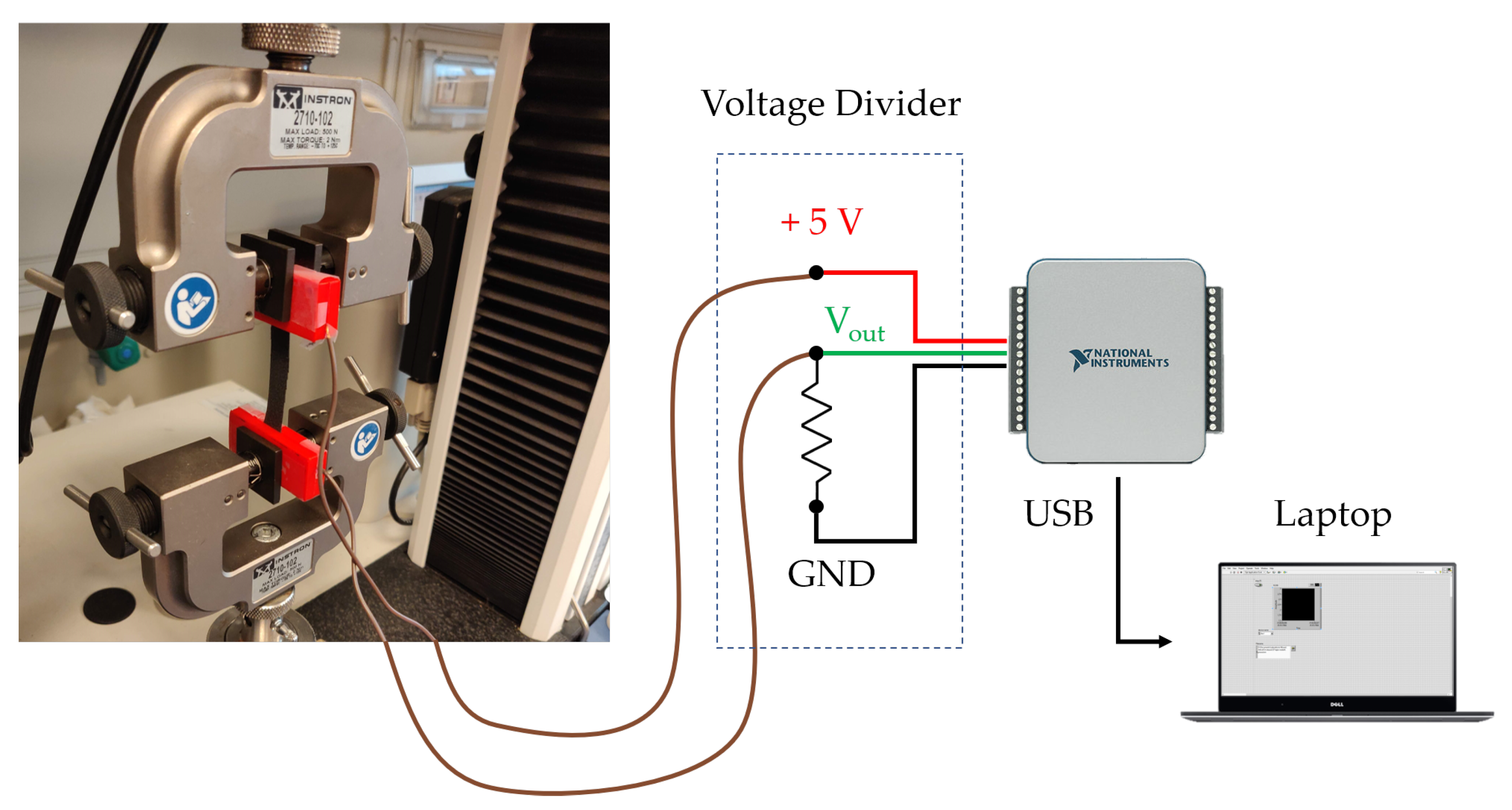
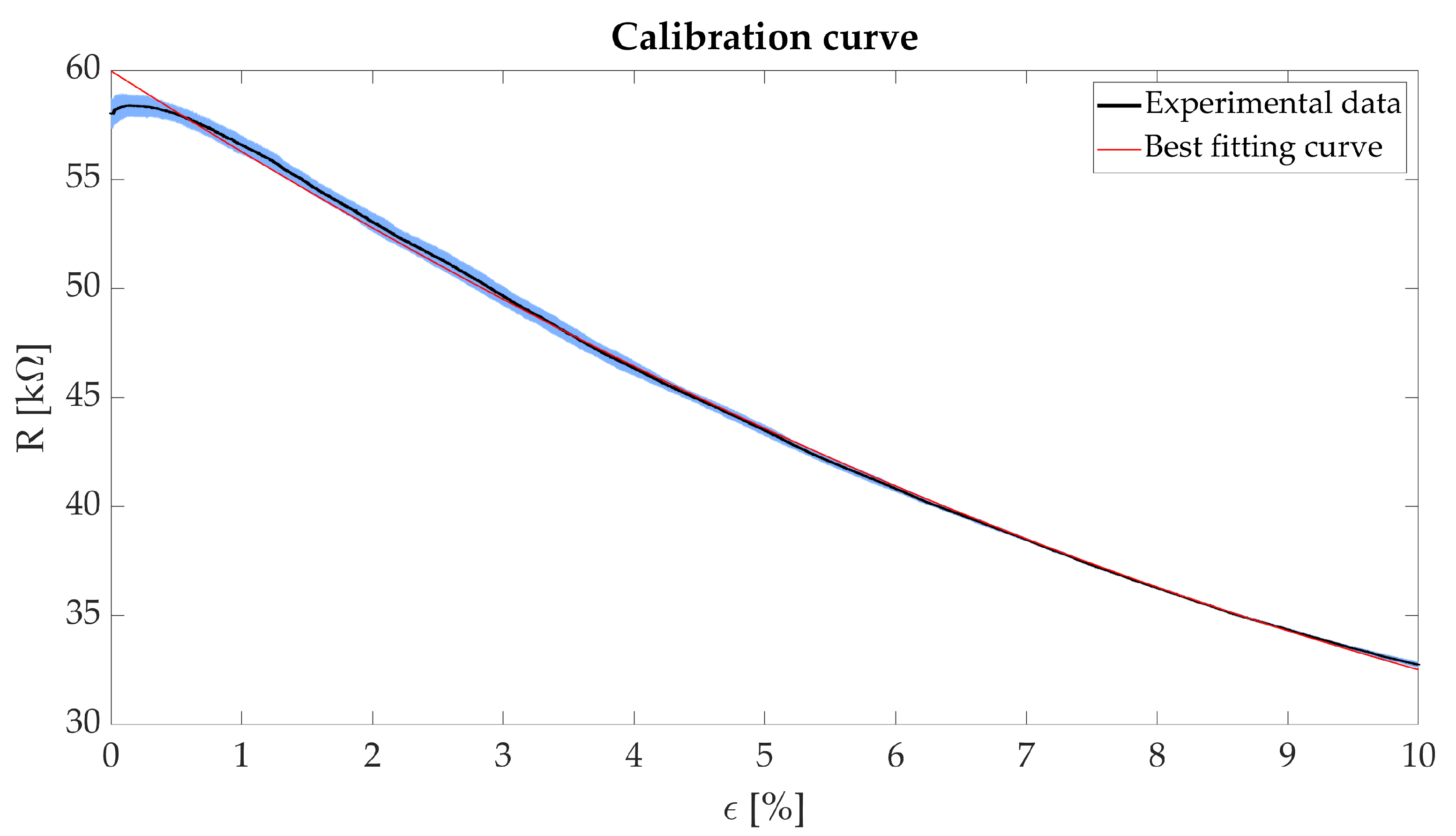
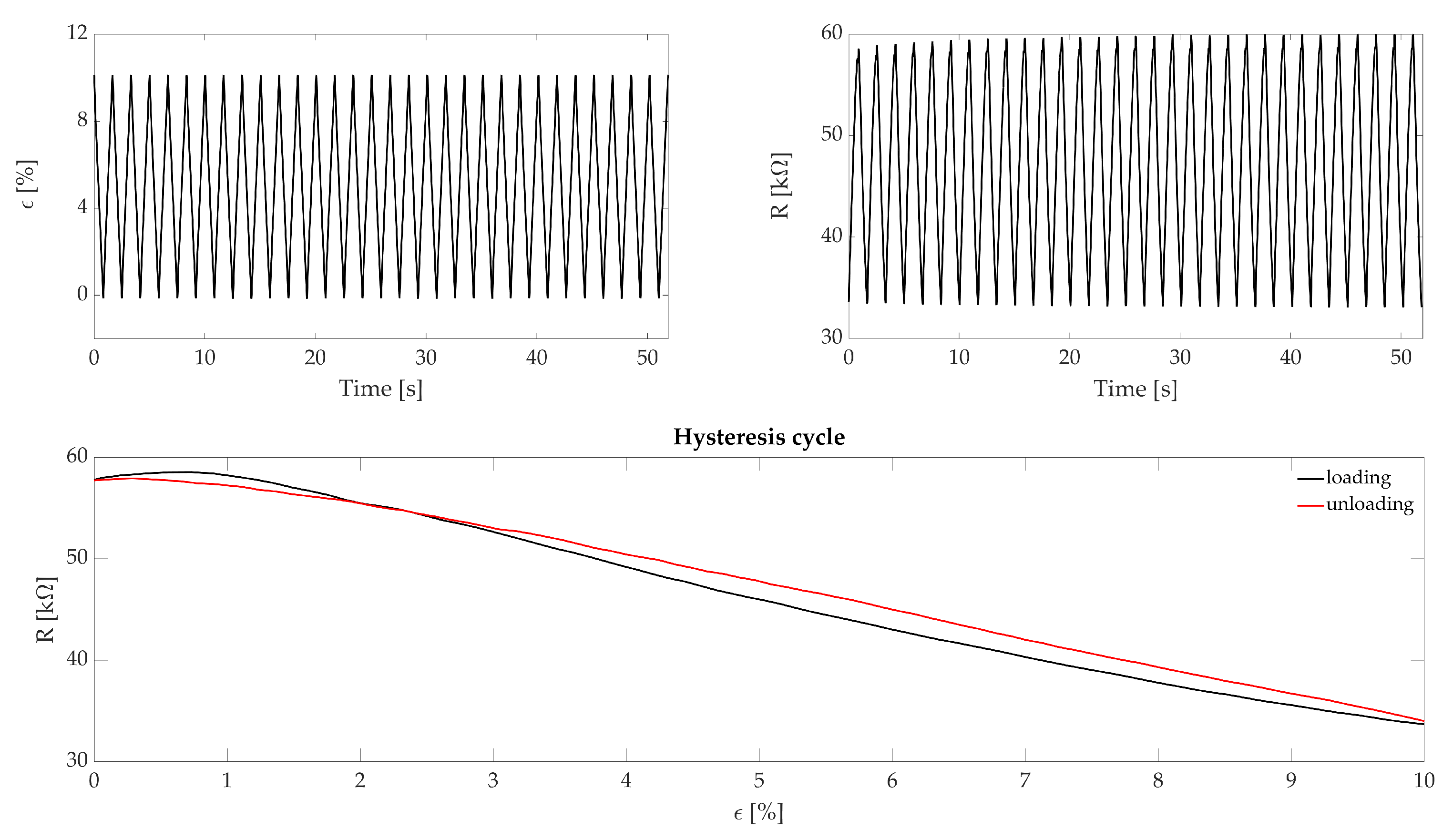
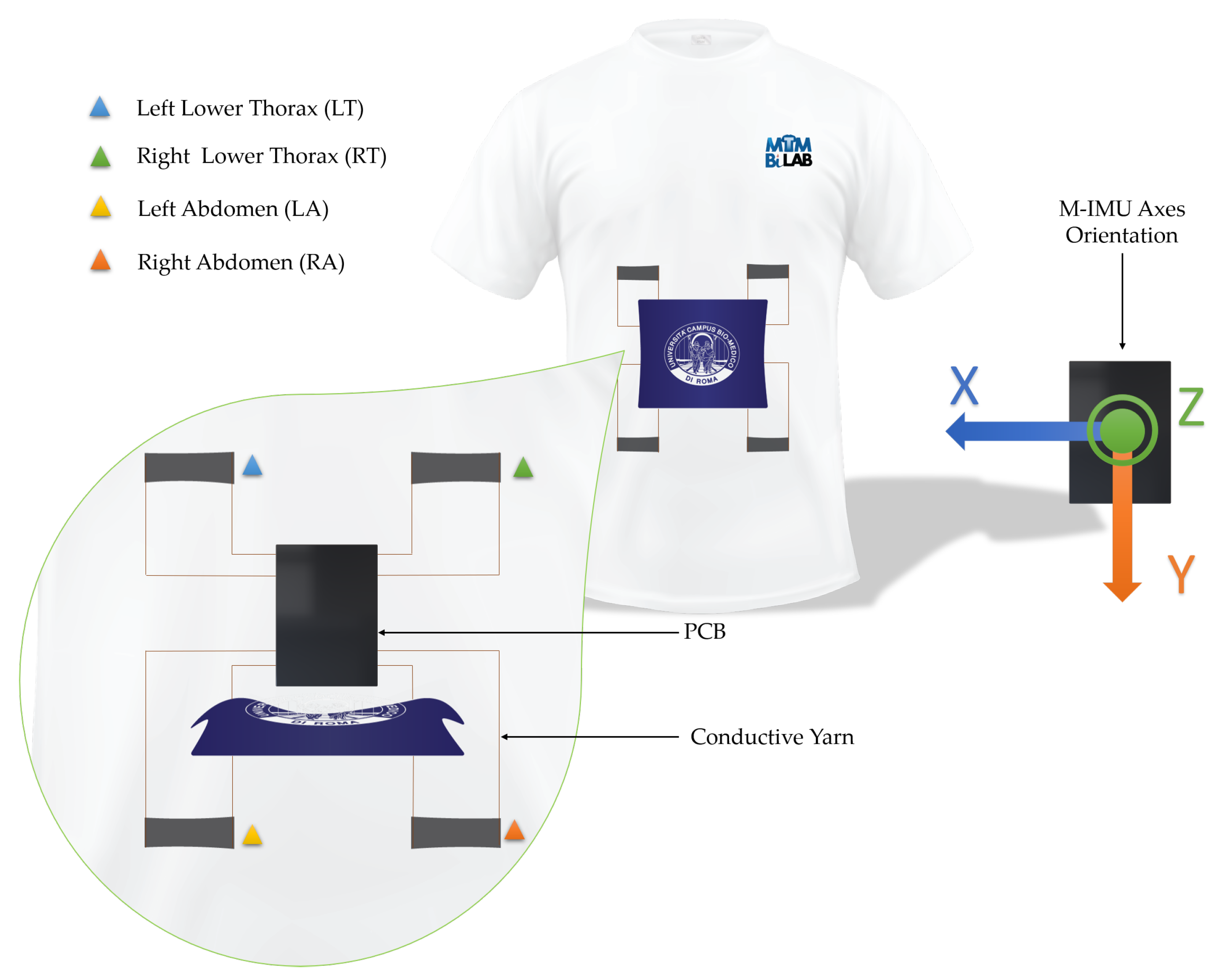

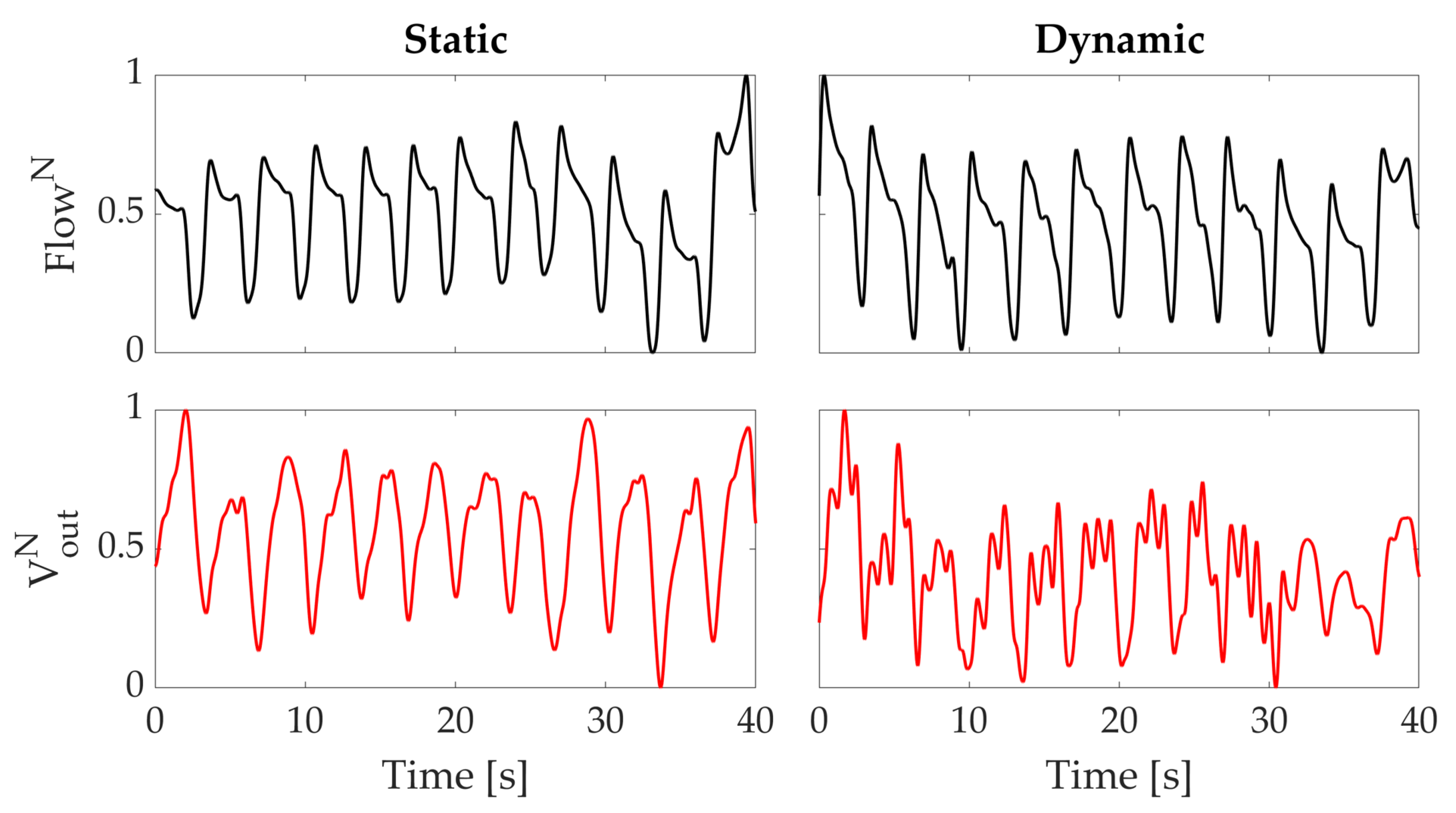
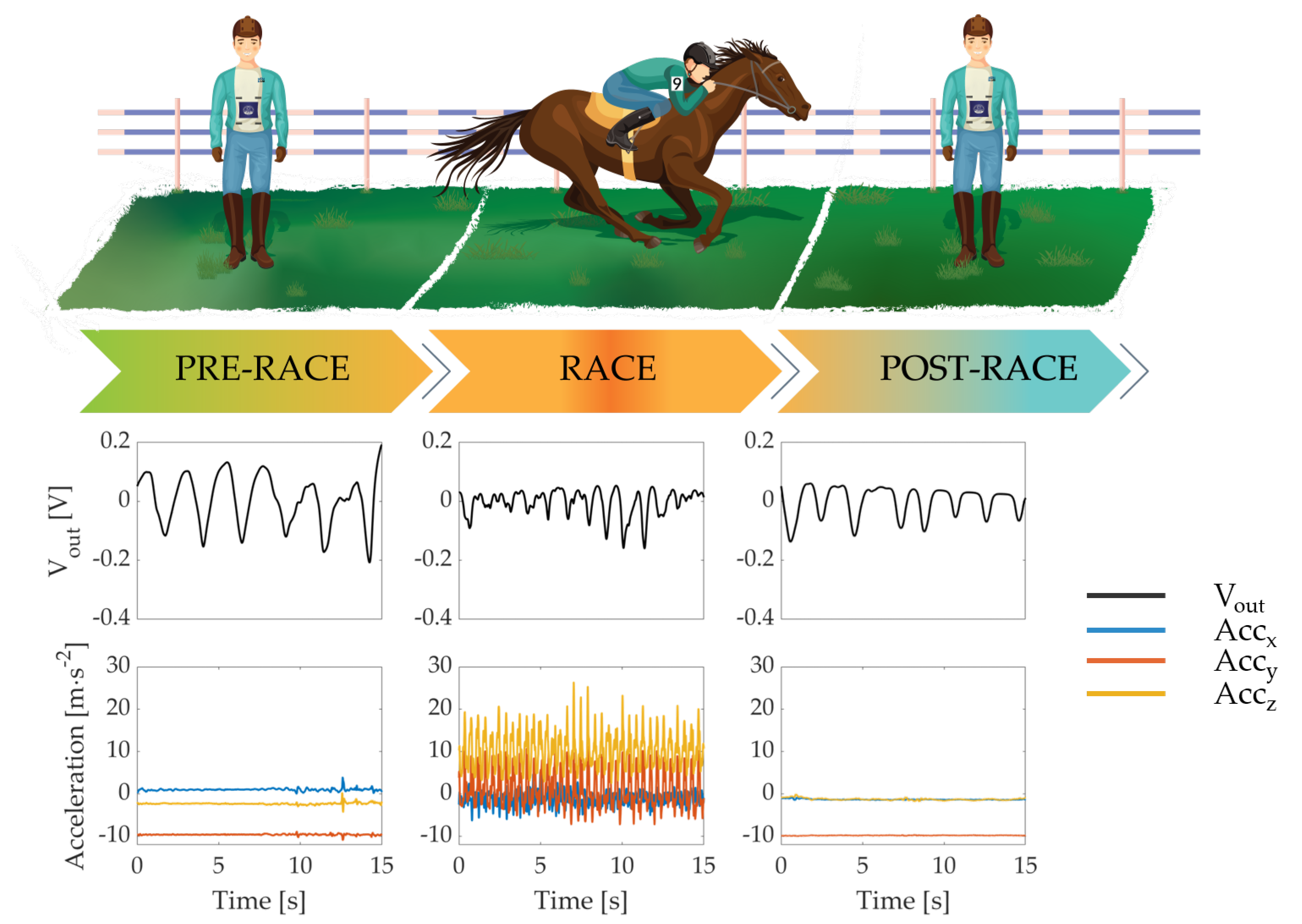
| Jockey | Height [cm] | Weight [kg] | BMI [kg/m] | Sex | Age [y] |
|---|---|---|---|---|---|
| 1 | 160 | 50 | 19.5 | Male | 26 |
| 2 | 158 | 48 | 19.2 | Female | 26 |
| Jockey | Pre-Race [bpm] | Race [bpm] | Post-Race [bpm] |
|---|---|---|---|
| 1 | 24.0 | 38.5 | 29.7 |
| 2 | 30.1 | 52.3 | 17.8 |
Publisher’s Note: MDPI stays neutral with regard to jurisdictional claims in published maps and institutional affiliations. |
© 2020 by the authors. Licensee MDPI, Basel, Switzerland. This article is an open access article distributed under the terms and conditions of the Creative Commons Attribution (CC BY) license (http://creativecommons.org/licenses/by/4.0/).
Share and Cite
Di Tocco, J.; Sabbadini, R.; Raiano, L.; Fani, F.; Ripani, S.; Schena, E.; Formica, D.; Massaroni, C. Breath-Jockey: Development and Feasibility Assessment of a Wearable System for Respiratory Rate and Kinematic Parameter Estimation for Gallop Athletes. Sensors 2021, 21, 152. https://doi.org/10.3390/s21010152
Di Tocco J, Sabbadini R, Raiano L, Fani F, Ripani S, Schena E, Formica D, Massaroni C. Breath-Jockey: Development and Feasibility Assessment of a Wearable System for Respiratory Rate and Kinematic Parameter Estimation for Gallop Athletes. Sensors. 2021; 21(1):152. https://doi.org/10.3390/s21010152
Chicago/Turabian StyleDi Tocco, Joshua, Riccardo Sabbadini, Luigi Raiano, Federica Fani, Simone Ripani, Emiliano Schena, Domenico Formica, and Carlo Massaroni. 2021. "Breath-Jockey: Development and Feasibility Assessment of a Wearable System for Respiratory Rate and Kinematic Parameter Estimation for Gallop Athletes" Sensors 21, no. 1: 152. https://doi.org/10.3390/s21010152
APA StyleDi Tocco, J., Sabbadini, R., Raiano, L., Fani, F., Ripani, S., Schena, E., Formica, D., & Massaroni, C. (2021). Breath-Jockey: Development and Feasibility Assessment of a Wearable System for Respiratory Rate and Kinematic Parameter Estimation for Gallop Athletes. Sensors, 21(1), 152. https://doi.org/10.3390/s21010152









